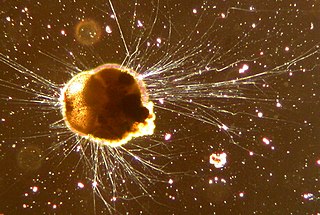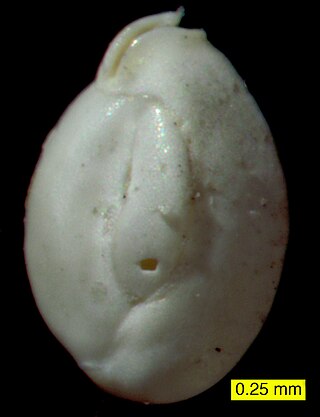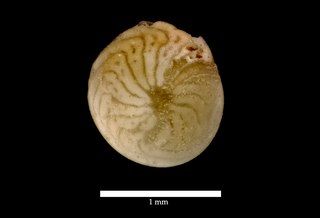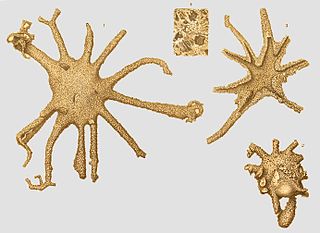Related Research Articles

Foraminifera are single-celled organisms, members of a phylum or class of Rhizarian protists characterized by streaming granular ectoplasm for catching food and other uses; and commonly an external shell of diverse forms and materials. Tests of chitin are believed to be the most primitive type. Most foraminifera are marine, the majority of which live on or within the seafloor sediment, while a smaller number float in the water column at various depths, which belong to the suborder Globigerinina. Fewer are known from freshwater or brackish conditions, and some very few (nonaquatic) soil species have been identified through molecular analysis of small subunit ribosomal DNA.

The Allogromiida is an order of single-chambered, mostly organic-walled foraminiferans, including some that produce agglutinated tests (Lagynacea). Genetic studies indicate that some foraminiferans with agglutinated tests, previously included in the Textulariida or as their own order Astrorhizida, may also belong here. Allogromiids produce relatively simple tests, usually with a single chamber, similar to those of other protists such as Gromia. They are found as both marine and freshwater forms, and are the oldest forms known from the fossil record.

The Fusulinida is an extinct order within the Foraminifera in which the tests are traditionally considered to have been composed of microgranular calcite. Like all forams, they were single-celled organisms. In advanced forms the test wall was differentiated into two or more layers. Loeblich and Tappan, 1988, gives a range from the Lower Silurian to the Upper Permian, with the fusulinid foraminifera going extinct with the Permian–Triassic extinction event. While the latter is true, a more supported projected timespan is from the Mid-Carboniferous period.

The Miliolida are an order of foraminifera with calcareous, porcelacous tests that are imperforate and commonly have a pseudochitinous lining. Tests are composed of randomly oriented calcite needles that have a high proportion of magnesium along with organic material. Tests lack pores and generally have multiple chambers.

The Textulariida are an order of foraminifera that produce agglutinated shells or tests. An agglutinated test is one made of foreign particles glued together with an organic or calcareous cement to form an external shell on the outside of the organism. Commonly, the order had been made up of all species of Foraminifera with these types of shells, but genetic studies indicate these organisms do not form an evolutionary group, and several superfamilies in the order have been moved to the order Allogromiida. The remaining forms are sometimes divided into three orders: the Trochamminida and Lituolida, which have organic cement, and the Textulariida sensu stricto, which use a calcareous cement. All three orders or superfamilies are known as fossils from the Cambrian onwards.

In biology, a test is the hard shell of some spherical marine animals and protists, notably sea urchins and microorganisms such as testate foraminiferans, radiolarians, and testate amoebae. The term is also applied to the covering of scale insects. The related Latin term testa is used for the hard seed coat of plant seeds.

The Asterigerinacea is a superfamily of Foraminifera included in the order Rotaliida, proposed by Loeblich and Tappan in 1988.
The Rzehakinidae is a family of Lower Cretaceous to recent formaminifera that resemble the calcareous imperforate Miliolidae but which are constructed of finely agglutinated material that veneers an organic base. Tests are with two, or less commonly three, chambers per whorl, which are commonly added in various planes. In form they are generally ovoid.
The Ammodiscacea is a superfamily of foraminifera in the order Textulariida. tests are made of agglutinated grains and consist of a proloculus followed by an enrolled tubular second chamber open at the distal end, that lacks internal septa but which may have growth constrictions.
The Hormosinacea is a superfamily of agglutinated foraminifera in the Textulariida, with a range that extends from the Middle Ordovician, that unites seven families characterized by multilocular tests,, in a uniserial arrangement.
Sigmoilinopsis is a genus of miliolid Foraminifera, with an ovate test, chambers one-half coil in length, arranged in rapidly changing planes in the early stage resulting in two spiralling series that appear sigmoid in section, gradually becoming planispiral in the adult. Walls are thick, porcelaneous but enclosing a large quantity of agglutinated quartz particles, sponge spicules, and shell fragments; the aperture terminal, rounded, with a small tooth.
Miliollata is a class wherein Foraminifera is regarded as a phylum that unites the porcelaneous Miliolida, and siliceous Rzehakinidae based on similarities of their tests. Previously the Rzehakinidae were included in the Textulariina based on test wall composition rather than test form. The meaning of Miliolida is retained.

Astrorhizana are a subclass of foraminifera characterized by simple tests composed of agglutinated material that can be irregular, spheroidal, or tubular and straight, branching or enrolled. Tests are non septate and consist of a single chamber following the proloculus. These are the Ammodiscacea of the Textulariina in the Treatise Part C, that range from the Cambrian to Recent.
Lagynana is a subclass of foraminifera which comprises Astrorhizata with membranous or pseudochitinous tests that may have ferruginous encrustations or more rarely small quantities of agglutinated material. The Lagynacea Schultze, 1854, of the Allogriomiina, is fairly equivalent.
Alfred R. Loeblich Jr (1914–1994) was an American micropaleontologist. He was married to Helen Niña Tappan Loeblich and the two co-authored a number of important works on the Foraminifera and related organisms.
Miliolana is a subclass established by Saidova, 1981 that comprises porcelaneous members of the Miliolata from the Cornuspirida, Miliolida with agglutinated forms removed to the Miliamminana, and Soritida. Included are both free and attached forms, some coiled with two chambers per whorl arranged in different planes, others that are irregular or have serial chambers, and still others are fusiform with complex interiors, superficially resembling the Fusulinacea. The unifying character is their imperforate porcelaneous tests.

Cyclamminidae is a family of Foraminifera in the order Loftusiida, ex textulariid subfamily Cyclammininae in the Treatise on Invertebrate Paleontology Part C, Protista 2.
Haurania is a genus of elongated, finely agglutinated benthic foraminifera included in the Spirocyclinidae. The test is free, starting with a brief planispiral coil followed by a straight uncoiled stage. The exterior is imperforate, the interior divided by radial septula or beams, perpendicular to the septa and outer wall. The aperture is cribrate, a series of openings on the terminal face.
Martiguesia is a genus of agglutinated benthic forams from the Upper Cretaceous (Santonian) of France. The test is free, the early stage planispirally coiled, becoming nearly straight during later growth. The agglutinated wall is externally imperforate, the interior with a coarse alveolar network. Chambers are subdivided and almost completely filled by irregular radial pillars. The aperture, cribrate.
Pseudospirocyclina is a genus of large planispirally coiled agglutinated benthic forams with a complex interior known from the upper Jurassic (Kimmeridgian) of Portugal and Morocco.
References
- [1]
- [2]
- Miliolata-Foraminifera
- Alfred R Loeblich jr & Helen Tappan, 1964. Treatise on Invertebrate Paleontology, Part C, Protista 2; Sarcodina, chiefly "Thecamoibians" and Foraminiferida. Geological Society of America and University of Kansas Press.